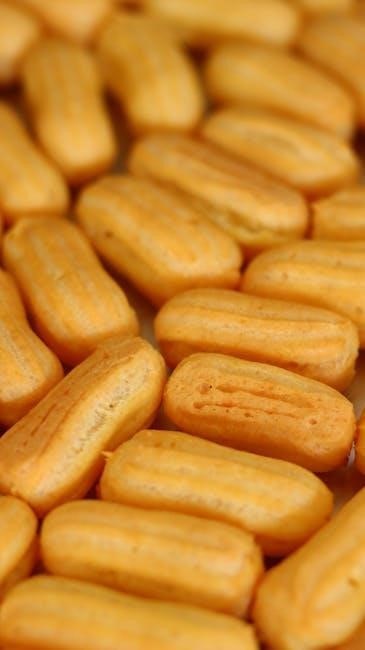Understanding the Importance of Portion Sizes for Diabetics
Managing blood glucose levels requires careful attention to portion sizes, as they directly impact blood sugar fluctuations. Proper portion control helps maintain a healthy weight, reduces the risk of complications, and ensures balanced nutrition. For diabetics, understanding and monitoring food intake is essential to prevent excessive sugar spikes and maintain overall health.
Why Portion Control Matters for Blood Sugar Management
Portion control is crucial for managing blood sugar levels, as it prevents excessive carbohydrate intake that can lead to glucose spikes. By regulating food quantities, individuals with diabetes can maintain stable blood sugar levels, reducing the risk of complications. Proper portion sizes also help in achieving and maintaining a healthy weight, which is essential for insulin sensitivity. Balanced nutrition is key, and controlling portions ensures that meals are nutrient-dense while avoiding overconsumption of sugars and fats. Understanding and implementing portion control strategies is vital for long-term diabetes management and overall health. It helps individuals make informed food choices, promoting better blood sugar regulation and reducing the risk of diabetes-related health issues.
Differences Between Serving Sizes and Portion Sizes
Serving sizes and portion sizes are often confused but serve distinct purposes. Serving sizes are standardized measurements determined by food manufacturers and regulatory bodies, providing a reference for nutrition information on labels. They help consumers understand the nutritional content per serving. Portion sizes, however, refer to the actual amount of food an individual consumes in one sitting. Unlike serving sizes, portion sizes vary based on personal appetite, dietary needs, and cultural habits. For diabetics, understanding this difference is crucial, as portion control directly impacts blood sugar levels. While serving sizes guide nutrition decisions, portion sizes reflect real consumption and should be tailored to individual health goals and carbohydrate intake limits to manage diabetes effectively.

Navigating Nutrition Labels for Better Diabetes Management
Reading nutrition labels is crucial for managing diabetes. Focus on serving sizes, carbohydrates, and fats to make informed choices that stabilize blood sugar levels effectively.
How to Read and Interpret Serving Sizes on Food Labels
Reading and interpreting serving sizes on food labels is essential for diabetes management. Start by locating the “Serving Size” section, which indicates the standard amount of food the nutritional information refers to. Check both the serving size in grams or cups and the number of servings per container. Be aware that serving sizes are standardized but may not match your actual portion. Pay attention to macronutrients, especially carbohydrates, as they directly affect blood sugar. Use measuring cups or a food scale to align your portions with the label’s guidelines. Comparing similar products can also help make healthier choices. Accurately interpreting serving sizes ensures better control over carbohydrate intake and blood sugar levels, making it a vital skill for effective diabetes management.
Understanding the Role of Carbohydrates in Portion Sizes
Carbohydrates play a crucial role in portion size management for diabetics, as they directly impact blood sugar levels. Focus on complex carbs like whole grains, fruits, and vegetables, which release glucose slowly. Simple carbs, such as sugars and refined grains, should be limited due to their rapid effect on blood glucose. Counting carbs helps maintain balanced portions and prevents spikes. Use resources like food labels or carb-counting guides to measure intake accurately. Pairing carbs with protein or healthy fats can slow digestion and stabilize blood sugar. Understanding carbohydrate portion sizes is key to maintaining glucose control and overall health for individuals with diabetes.


Food Group Portion Sizes for Diabetics
Balanced meals for diabetics require specific portion sizes for each food group. Carbohydrates, proteins, fats, and vegetables must be measured to control blood sugar and ensure nutrition. Proper allocation helps avoid glucose spikes and supports overall health, making portion control essential for effective diabetes management.
Recommended Portion Sizes for Carbohydrates
For diabetics, managing carbohydrate intake is crucial as carbs directly affect blood sugar levels. The recommended portion size for carbohydrates varies but typically ranges between 45-60 grams per meal for women and 60-75 grams for men, depending on activity levels and weight goals. It’s important to focus on complex carbs like whole grains, fruits, and vegetables, which have a slower glycemic impact. Portion control tools, such as food scales or measuring cups, can help accurately measure carbohydrate servings. Additionally, pairing carbs with protein or healthy fats can reduce glycemic spikes, promoting better blood sugar balance and overall metabolic health. Consulting a dietitian can provide personalized portion guidelines tailored to individual needs.

Guidelines for Protein Sources in Diabetic Diets

For diabetics, incorporating high-quality protein sources is essential for maintaining blood sugar balance and overall health. Recommended portion sizes for protein typically range between 3-4 ounces per serving, with 2-3 servings daily. Lean proteins like poultry, fish, and plant-based options such as legumes and tofu are ideal. These choices help stabilize blood sugar levels and reduce the risk of heart disease, a common complication of diabetes. Additionally, protein-rich foods can enhance satiety, aiding in weight management. It’s important to opt for low-fat or fat-free options and avoid processed meats high in sodium. Pairing protein with vegetables or whole grains creates balanced meals that support glucose control and long-term health. Always consult a healthcare provider or dietitian for personalized protein intake recommendations.
Healthy Fat Portion Sizes for Blood Sugar Balance
Incorporating healthy fats into a diabetic diet is crucial for blood sugar balance and overall health. Recommended portion sizes for healthy fats are typically 1-2 tablespoons per serving, with 2-3 servings daily. Sources like avocados, nuts, seeds, and olive oil are ideal, as they provide sustained energy and improve insulin sensitivity. These fats also reduce inflammation and lower the risk of heart disease. Avoid trans fats and saturated fats found in processed foods and fried items. Balancing healthy fats with other food groups ensures meals are satisfying and nutritionally complete, supporting stable blood sugar levels and long-term health. Always refer to a trusted diabetes nutrition guide for specific portion recommendations tailored to individual needs.
Vegetable Portion Sizes and Their Impact on Diabetes
Vegetables play a vital role in diabetes management due to their low carbohydrate content and high fiber, which helps regulate blood sugar levels. Diabetics are encouraged to consume 5-6 servings of vegetables daily. A serving size is typically 1/2 cup cooked or 1 cup raw. Non-starchy vegetables like spinach, broccoli, and bell peppers are ideal, as they have minimal impact on blood glucose. Starchy vegetables, such as potatoes and corn, should be consumed in smaller portions (1/3 cup cooked per serving). Incorporating a variety of colorful vegetables ensures essential nutrients and fiber, promoting satiety and improving insulin sensitivity. This balanced intake supports overall health and helps maintain stable blood sugar levels, reducing the risk of complications associated with diabetes.


Practical Meal Planning Strategies
Effective meal planning involves balancing nutrients, controlling portions, and scheduling meals to maintain stable blood sugar levels. Using portion control tools and creating a weekly menu can simplify the process and ensure consistency. Prioritizing whole, unprocessed foods like vegetables, lean proteins, and whole grains helps regulate blood glucose. Regular meals and snacks spaced evenly throughout the day prevent extreme hunger and overeating, while keeping track of carbohydrates is crucial for managing insulin levels. Staying hydrated and incorporating physical activity further enhances the benefits of a well-planned diet, promoting overall health and reducing diabetes-related risks. Consistency and variety are key to maintaining a sustainable and enjoyable eating plan.
How to Measure and Control Portion Sizes at Home
Measuring and controlling portion sizes at home is crucial for managing blood sugar levels. Using food scales or measuring cups ensures accuracy, especially for carbohydrates and proteins. Visual guides, like comparing food portions to everyday objects, can help estimate sizes without tools. Dividing meals into sections on the plate—half for vegetables, a quarter for protein, and a quarter for carbs—promotes balance. Pre-portioning snacks and storing them in individual containers prevents overeating. Labeling leftovers with their contents and portion sizes aids in tracking intake. Regularly reviewing and adjusting portion sizes based on dietary needs and weight changes helps maintain long-term control. Consistency and awareness are key to making portion control a sustainable habit.
Creating Balanced Meals for Optimal Blood Sugar Levels
Creating balanced meals is essential for managing blood sugar levels in diabetics. Each meal should include a mix of carbohydrates, proteins, and healthy fats, with portion sizes tailored to individual needs. Carbohydrates, which directly impact blood sugar, should be balanced with fiber-rich foods like whole grains and vegetables. Protein sources, such as lean meats or legumes, help stabilize glucose levels, while healthy fats like avocados and nuts reduce inflammation. Vegetables, especially non-starchy ones, should make up a significant portion of the plate. Meal planning and prepping can help maintain consistency, while using visual guides ensures proper portion sizes. Balancing these elements not only controls blood sugar but also promotes overall health and weight management, making mealtime a key part of diabetes care.
Visual Guides and Resources for Diabetes Portion Control
Visual guides, such as portion size charts and downloadable PDFs, provide practical tools for measuring food portions accurately. These resources help simplify portion control, ensuring consistency and accuracy for better blood sugar management.

Using Portion Size Charts and PDF Guides for Convenience
Portion size charts and PDF guides are invaluable tools for managing diabetes. These resources provide clear visuals and measurements, making it easier to gauge appropriate food portions. They often include detailed breakdowns of carbohydrates, proteins, and fats, helping to maintain balanced meals. Many guides are designed to be printed, offering a quick reference during meal prep. By using these resources, individuals can track their intake more effectively, leading to better blood sugar control and overall health. They are especially useful for those who prefer visual aids or need a straightforward approach to portion management.
